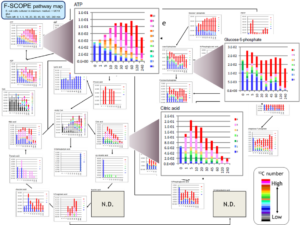Metabolic Flux Analysis
While detailed metabolite profiling may reveal dysregulated pathways and metabolites, following heavy atom isotopomers of Glucose, Glutamine, Glutamate, Leucine and other metabolites enables one to monitor the flow of carbons and nitrogens in a system to better understand metabolite flow. Such studies may allow unique understanding of specific target points for drug interactions. While used mostly for cancer cell studies, such studies cover a wide range of diseases that involve mitochondrial and glycolytic pathways for growth and survival.
Isotope Flux Analysis
 Heavy isotope flux analysis, which use substrates including 13C or 15N, provides insight into the direction and flow of those labeled markers, typically glucose or glutamine.
Heavy isotope flux analysis, which use substrates including 13C or 15N, provides insight into the direction and flow of those labeled markers, typically glucose or glutamine.
For glycolysis, lactate, the final product, is considered as an indicator of glycolytic output, but information from steady state metabolic levels is limited because it reveals only the balance between production and consumption. Labeling analysis using 13C glucose can quantify the production derived from glucose which is a direct indicator of pathway activity.
Heavy isotope analyses can also often be used to distinguish between multiple enzymatic reactions that result in the same product. For example, citrate can be formed from the traditional oxidative reactions of the TCA cycle, however, it can also be formed from a reversal of the cycle via reductive carboxylation. Unlabeled steady state measurements cannot definitively determine the directionality of the cycle. However, by using uniformly 13C labeled glutamine, a clearer picture can emerge as one carbon will be lost as C02 via the oxidative pathway, while all 5 carbons will be retained via the reductive pathway. Therefore, analyzing the change in percentage of 4 or 5 labeled carbons in citrate can give clues to changes in the directionality of the TCA cycle.
These approaches can identify metabolic targets for therapeutic intervention, as well as metabolic pathways that are altered as a result of treatment.
HMT is committed to providing our unique C13 analyses for cultured cells, as well as, in the in vivo setting.
